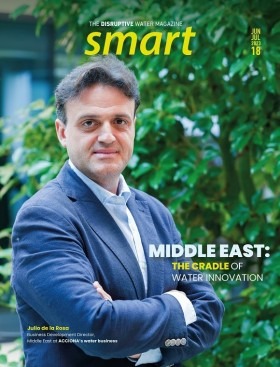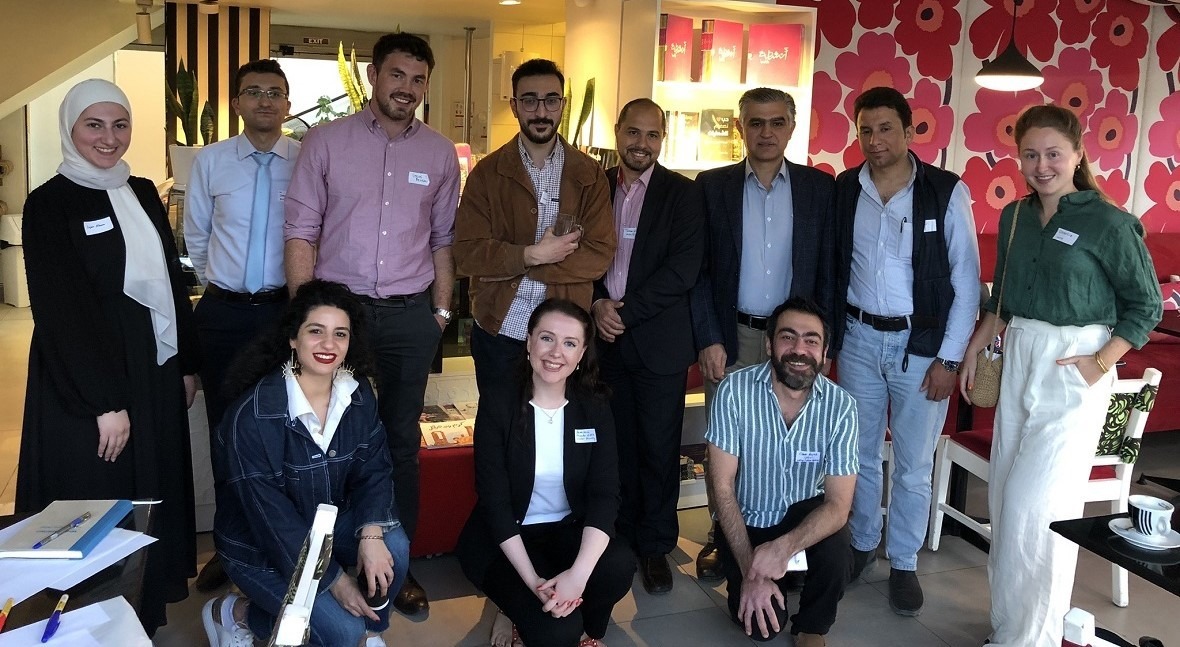“The Middle East is facing a perfect storm of both man-made and climate-related water crises”

The Middle East is a very diverse region but many countries have in common a high level of water stress and rapidly expanding populations that will drive increased consumption to meet the needs of people, agriculture and businesses.
Water security covers many aspects, though it can be understood to refer to the availability of water in adequate quantity and quality for human well-being, socio-economic development, and ecosystem health. Smart Water Magazine had a chance to interview Jemima Oakey, Consultant on Middle Eastern Water and Food Security and founder of the Green Futures Network, to get a glimpse of water security issues in the region: concerns, successes, and the path ahead to achieve a water secure future.
Please tell us briefly about your career path and your current involvement with water issues.
I am an Associate in Middle Eastern water and food security at London-based consultancy, Azure Strategy and a consultant on the region for AKE International. I have previously consulted for Middle Eastern governments on their food and water security strategies and worked with development institutes, think tanks and NGOs based in the region on natural resource management. Recently, I founded the Green Futures Network which seeks to bring together environmental professionals in the region to debate how to build a water-secure and green future for the Middle East through monthly networking events. Previously I was the Middle East Analyst at Global Water Intelligence and have also worked on transboundary water issues with EcoPeace Middle East.
What are the key challenges and factors contributing to water security concerns in the Middle East region?
The Middle East’s water security challenges do not originate solely from climate change, although it has exacerbated water scarcity issues
The Middle East’s water security challenges do not originate solely from climate change, although this serves to exacerbate pre-existing water scarcity issues. Historic mismanagement, rapidly expanding population growth, unsustainable abstraction of natural resources and conflict have all contributed to driving water scarcity. For example, Jordan has faced successive large-scale influxes of refugees which has drastically reduced its water availability per capita. Unsustainable groundwater extractions conducted throughout the region, but most notably in Yemen, continue to deplete groundwater levels at an unsustainable rate, leaving emergency aquifer reserves extremely low and at risk of saline intrusion. In the majority of the Gulf, domestic water consumption typically exceeds 450 litres per person per day - in the UK consumption is around 145 litres per person per day. And in Syria over a decade of conflict has seen water infrastructure decimated and water resources polluted. The Middle East is facing a perfect storm of both man-made and climate-related water crises which need urgent redress.
Can you comment on the implications of water and food security for regional stability in the Middle East?
There is a widely held misconception in the media that water insecurity naturally generates conflict. This is an incorrect and unhelpful narrative and to subscribe to this narrative risks governments and international organisations funnelling money towards solutions that further securitise water rather than addressing issues that tackle water insecurity itself.
Water and food insecurity instead act as “threat and risk multipliers” for regional stability by amplifying the threats posed by preexisting social, economic or political issues. Therefore, when countries already suffering from severe economic hardship and/or political turmoil also face water scarcity, these preexisting issues have an increased chance of escalating and becoming crises that compromise regional stability.
Despite the Gulf being the region’s hub for cutting edge innovation related to water, it has high levels of domestic water consumption
Food security is intrinsically tied to water security; you cannot have food security without water security. Countries such as Egypt which face absolute water scarcity have weakened food security situations as domestic food production is severely constrained due to insufficient water resources. Consequently, they risk import dependency for their food security. This dependency is problematic when food supplies are compromised by shocks to the international market thereby destabilising regional economic stability. This was recently exemplified by Russia’s invasion of Ukraine.
What are some successful examples of water management and conservation strategies implemented in the region to address water scarcity and ensure long-term sustainability?
Israel’s national water company, Mekorot, has some of the most successful water management and conservation strategies in the region. Since the signing of the Abraham Accords, signatory countries have quickly sought to make the most of Israel’s expertise. Mekorot has successfully managed to reduce Israel’s non-revenue water to around 3%, and recycles 85% of its wastewater. In addition to this, over 70% of its domestic water resources is desalinated water.
The high consumer demand drains much of the desalinated supply and prevents agriculture from moving away from groundwater abstractions
These are very successful water management and conservation strategies. However, the water situations in the West Bank and Gaza are vastly different. Water security must be for all, as failing to manage all water resources properly endangers the long-term sustainability of Israel’s overall water security. Israel regularly cuts the electricity supply to Gaza, leaving Gaza unable to treat its wastewater. Therefore, there is a huge runoff of raw effluent into the Mediterranean from Gaza. This causes pollution of local water resources and operational disruption to some of Israel’s largest desalination plants. It is therefore in everyone’s interests to have successful water management and conservation strategies for all water resources in order to have a truly sustainable and secure water situation.

To what extent are the different countries in the region adopting innovative approaches and technologies to deal with water scarcity?
The extent to which different countries in the region are adopting innovative approaches and technologies differs widely depending on their financial resources and which aspects of water scarcity are most pressing for each country. Whilst there are many successful projects underway, no country has successfully addressed water scarcity in its entirety and developed a truly circular economy.
Despite the Gulf being the region’s hub for cutting-edge innovation and technological developments related to water, it has extremely high levels of domestic water consumption which restrict its progress towards achieving water security. Jordan is developing a desalination plant in Aqaba to help generate an estimated 250 million cubic metres of extra water per year and increase availability per capita. However, it still loses approximately 50% of its water through non-revenue water each year, leaving it in a vulnerable position. Egypt is adapting its water security by reforming its agricultural sector through irrigation upgrades and is soon to increase its available water resources by developing 17 new desalination plants. Yet the completion of the Grand Ethiopian Renaissance Dam (GERD) will soon decrease Egypt’s available water resources. Egypt therefore must work with Ethiopia to develop an innovative water sharing agreement which forecasts dam releases with advanced modelling technologies.
These examples serve to illustrate how many complex dimensions there are to achieving water scarcity and the huge efforts required to fully secure the Middle East’s water future.
Some Middle East countries have very high per capita water consumption compared to the global average. Do you see a role for demand management policies to help address water scarcity in the future?
Russia’s invasion of Ukraine has shone a harsh light on many Middle Eastern countries’ import dependency for their food security
The UN suggests that per capita water consumption should be 100 litres per person per day. However, in much of the Gulf water consumption reaches well over 450 litres per person per day. Demand has to be addressed; as desalination becomes cheaper it becomes more feasible to use desalinated water in agriculture. The unnecessarily high consumer demand drains much of the desalinated supply and prevents agriculture from moving away from groundwater abstractions. This in turn deprives future generations of emergency groundwater reserves for times of extreme scarcity. Domestic demand management is a feasible policy which governments can achieve through public awareness campaigns; Jordan successfully encouraged consumer consumption saving by communicating through schools, mosques and the media. Consumption must be managed urgently to ensure groundwater resources are protected and rehabilitated for future generations to use.
What are your thoughts about balancing self-reliance in terms of agricultural production in very arid countries and ensuring sustainable water supplies in the long term?
This is a very timely question. Russia’s invasion of Ukraine has shone a harsh light on many Middle Eastern countries’ import dependency for their food security. Countries such as Yemen, Lebanon and Egypt imported more than 60% of their wheat from Russia and Ukraine. Ukraine’s loss of arable land and damage to its ports, combined with Western sanctions on Russia, has made sourcing wheat from Russia and Ukraine incredibly difficult. Therefore, some countries, like Egypt, are seeking to expand their agricultural capabilities to increase their national food production and reduce dependency on other countries and their subsequent exposure and vulnerability to market shocks.

However, this is extremely tricky to do. In most of the Middle East, agriculture is the single biggest consumer of water resources. Agriculture’s high-water consumption is in part due to the production of water intensive foodstuffs not suited to their domestic climate and inefficient irrigation practices. Staying with Egypt as a case study, Egypt has 560 m3 per capita per year - the UN states absolute water scarcity as 500 m3 per capita per year. Despite the planned construction of 17 new desalination plants, Egypt will still lack the water resources necessary to expand its arable land enough to grow the wheat required to make up for the deficit from Ukraine. Therefore, countries experiencing this are in a very difficult predicament and require the support of the international community to improve the quality and efficient use of existing water resources and rethink the best approaches to agricultural production.
Can you tell us about your expectations for the decarbonisation of water production and management services, in particular desalination?
For regions such as the Middle East, where ensuring supply and sanitation coverage are a top priority, decarbonisation falls by the wayside
The water sector, particularly desalination, has a large carbon footprint contributing to 2% of global emissions - roughly the same as the global shipping industry. Much attention has been paid recently by water utilities and the desalination industry on how to reduce the water sector’s carbon emissions and impact on the environment. This has seen the increased incorporation of solar energy into desalination plants, the improved efficiency of wastewater and desalination plants’ operational practices through the implementation of new technologies and increased attention to brine disposal management. So far Australia, the UK, the Netherlands and Denmark have led the way in decarbonisation efforts. However, whilst IWA and Xylem recently reported that 50% of energy-related emissions from the wastewater sector can be eliminated through better implementing new technologies, many utilities need support in tackling emissions. For regions such as the Middle East, where ensuring supply and extending wastewater network coverage is the top priority, decarbonisation understandably falls by the wayside. However, with the right support from governments and appropriate financing, low-carbon and net-zero water networks can be incorporated into the roll out of network coverage and the creation of desalinated water.
Looking towards the future, what are your predictions or recommendations for ensuring water security in the Middle East? Are there any emerging trends or areas of focus that need more attention?
The first challenge is to prevent the heating of the climate above 1.5 degrees Celsius through a global decarbonisation effort and move away from fossil fuels. A failure to stop the climate heating above 1.5 degrees Celsius will critically endanger any hopes of water security in the Middle East. A continually heating climate increases the likelihood and severity of droughts, loss of water resources and subsequent crop failures.
A failure to stop the climate heating above 1.5 degrees Celsius will critically endanger any hopes of water security for the Middle East
The second biggest challenge to water security in the Middle East is population growth. The UN cites the Middle East as holding 6% of the world’s population but less than 2% of its water resources. The region does not have the water resources to meet the demand of its existing population, and climate change will continue to reduce these resources whilst the population expands and demand increases. Domestic consumption, particularly in the Gulf, must be drastically decreased, existing water resources used efficiently and recycled, and new water resources developed with renewable energy-powered desalination plants in order to safeguard the resources of future increased populations.
This is a huge task which requires significant investment, consumer behavioural change and extensive agricultural reform. As this is a problem shared across the Middle East, and at a time of thawing regional political relations, tackling water scarcity is an issue Middle Eastern governments should solve together through cross-regional efforts.




